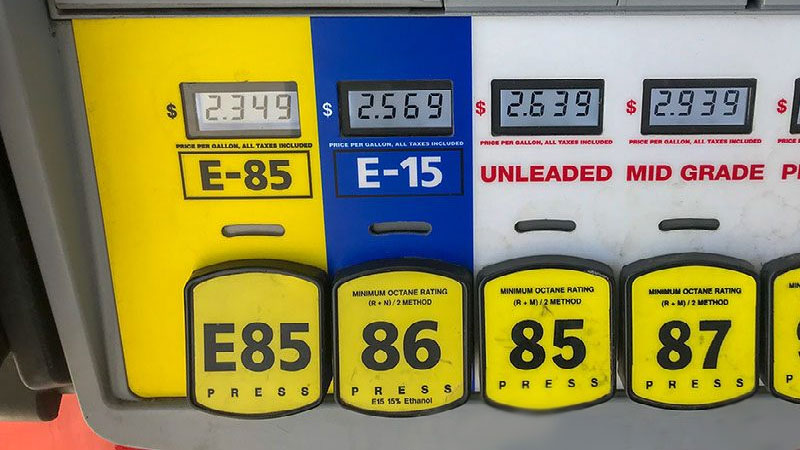Ethanol-blended fuel is generally sold as E85, consisting of 85 percent ethanol and 15 percent straight gasoline. This particular fuel is usually derived from corn or some other grain, or by means of using other renewable or recyclable materials.
E85 is relatively clean burning, provides more power to your car, but is less efficient than gasoline. Not all cars can run on E85, but yours might provided that at least one of the following three “clues” is in evidence.
How to Know If Your Car Can Use E85 Fuel
Clue No. 1: Badging
The most obvious indication that your car is E85 compatible is badging or other visible signage affixed to your car. Car manufacturers will often attach a badge stating “Flex Fuel” or “E85 Ethanol” somewhere on the body’s surface, usually at the rear or on the sides of the car.
Flex fuel means your car can run on straight gasoline or ethanol, signaling that the fuel system has upgraded plastic and rubber parts and a modified fuel sensor to detect the relative amount of ethanol to gasoline.
Clue No. 2: Placarding
With some flex-fuel vehicles, placarding is used to identify this capability. For instance, you may find a sticker affixed directly above the gas cap or inside the fuel door, indicating E85 compatibility.
In addition, some manufacturers use bright yellow gas caps and inscribe E85/Gasoline on the cover of the cap to denote its flex-fuel capabilities.
Clue No. 3: Owner’s Manual
Your owner’s manual provides a wealth of information about your car. Turn to the section about fuel to learn what types of fuel are recommended for your car.
If your car can take E85 fuel, that information will be clearly outlined in the manual.
American Lung Association
The most comprehensive list of flexible fuel vehicles listed online is tracked by the American Lung Association of the Upper Midwest’s “Clean Air Choice” website.
This list is updated regularly and includes all models produced since 1995 when select Ford Taurus models were built with flex-fuel capabilities. Moreover, the ALA doesn’t identify affected sub-models, but they do indicate which vehicles offer an FFV option.
Vehicle Identification Number (VIN)
Your vehicle’s 17-digit vehicle identification number may indicate its flex-fuel capability if no evidence can be found on the exterior of your car or in the owner’s manual. The VIN can usually be found on the driver’s side of the dashboard at the base of the windshield and viewed from the outside of your vehicle.
Each letter or digit also represents something about your vehicle including the year it was made, engine type, body style, country of origin and other factors. The eighth placement is reserved by some manufacturers, including Chrysler, to identify its flex-fuel capability.
Jot down your entire VIN and contact your dealer to determine whether your car is flex-fuel ready. If you’re considering buying a car and want to verify it’s flex-fuel capable, have the owner give you the VIN number.
E85 Order: No Specific Rules
The federal government hasn’t instituted rules to identify E85 vehicles, leaving that responsibility to automotive manufacturers. Flex-fuel vehicles began entering the market in the mid-1990s, which means that the aged sedan you bought for your son or daughter may be flex-fuel capable without your knowledge.
If in doubt about your car’s ethanol readiness, never use E85 as it can damage engine seals. E85 is also harder to find at service stations outside of the upper midwest and is up to 30 percent less fuel efficient than straight gasoline.
See Also — How Can I Tell If My Car is Flex-Fuel Capable?
Photo Credit: “INL E85 Fueling” by Idaho National Laboratory is licensed under CC BY 2.0
- 2024 Mazda CX-50: A Compact SUV with Premium Aspirations - Apr 15, 2024
- 2024 Ford Mustang (Iconic Pony Car Evolves) - Apr 4, 2024
- 2024 Ford Maverick (Looks Like a Truck, Drives Like a Car) - Mar 28, 2024




